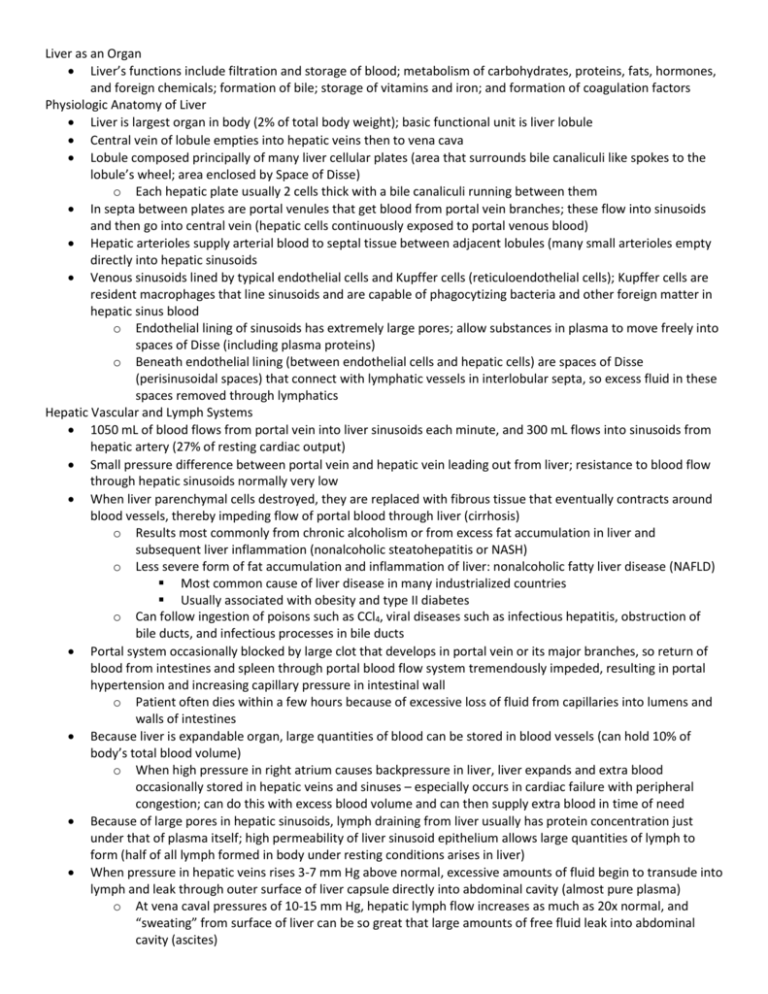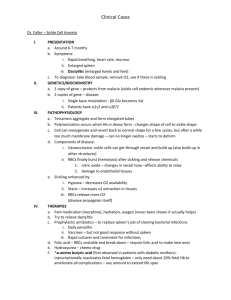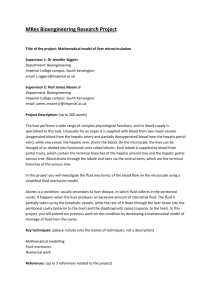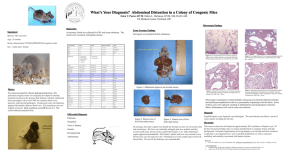phys chapter 70 [10-26
advertisement

Liver as an Organ Liver’s functions include filtration and storage of blood; metabolism of carbohydrates, proteins, fats, hormones, and foreign chemicals; formation of bile; storage of vitamins and iron; and formation of coagulation factors Physiologic Anatomy of Liver Liver is largest organ in body (2% of total body weight); basic functional unit is liver lobule Central vein of lobule empties into hepatic veins then to vena cava Lobule composed principally of many liver cellular plates (area that surrounds bile canaliculi like spokes to the lobule’s wheel; area enclosed by Space of Disse) o Each hepatic plate usually 2 cells thick with a bile canaliculi running between them In septa between plates are portal venules that get blood from portal vein branches; these flow into sinusoids and then go into central vein (hepatic cells continuously exposed to portal venous blood) Hepatic arterioles supply arterial blood to septal tissue between adjacent lobules (many small arterioles empty directly into hepatic sinusoids Venous sinusoids lined by typical endothelial cells and Kupffer cells (reticuloendothelial cells); Kupffer cells are resident macrophages that line sinusoids and are capable of phagocytizing bacteria and other foreign matter in hepatic sinus blood o Endothelial lining of sinusoids has extremely large pores; allow substances in plasma to move freely into spaces of Disse (including plasma proteins) o Beneath endothelial lining (between endothelial cells and hepatic cells) are spaces of Disse (perisinusoidal spaces) that connect with lymphatic vessels in interlobular septa, so excess fluid in these spaces removed through lymphatics Hepatic Vascular and Lymph Systems 1050 mL of blood flows from portal vein into liver sinusoids each minute, and 300 mL flows into sinusoids from hepatic artery (27% of resting cardiac output) Small pressure difference between portal vein and hepatic vein leading out from liver; resistance to blood flow through hepatic sinusoids normally very low When liver parenchymal cells destroyed, they are replaced with fibrous tissue that eventually contracts around blood vessels, thereby impeding flow of portal blood through liver (cirrhosis) o Results most commonly from chronic alcoholism or from excess fat accumulation in liver and subsequent liver inflammation (nonalcoholic steatohepatitis or NASH) o Less severe form of fat accumulation and inflammation of liver: nonalcoholic fatty liver disease (NAFLD) Most common cause of liver disease in many industrialized countries Usually associated with obesity and type II diabetes o Can follow ingestion of poisons such as CCl4, viral diseases such as infectious hepatitis, obstruction of bile ducts, and infectious processes in bile ducts Portal system occasionally blocked by large clot that develops in portal vein or its major branches, so return of blood from intestines and spleen through portal blood flow system tremendously impeded, resulting in portal hypertension and increasing capillary pressure in intestinal wall o Patient often dies within a few hours because of excessive loss of fluid from capillaries into lumens and walls of intestines Because liver is expandable organ, large quantities of blood can be stored in blood vessels (can hold 10% of body’s total blood volume) o When high pressure in right atrium causes backpressure in liver, liver expands and extra blood occasionally stored in hepatic veins and sinuses – especially occurs in cardiac failure with peripheral congestion; can do this with excess blood volume and can then supply extra blood in time of need Because of large pores in hepatic sinusoids, lymph draining from liver usually has protein concentration just under that of plasma itself; high permeability of liver sinusoid epithelium allows large quantities of lymph to form (half of all lymph formed in body under resting conditions arises in liver) When pressure in hepatic veins rises 3-7 mm Hg above normal, excessive amounts of fluid begin to transude into lymph and leak through outer surface of liver capsule directly into abdominal cavity (almost pure plasma) o At vena caval pressures of 10-15 mm Hg, hepatic lymph flow increases as much as 20x normal, and “sweating” from surface of liver can be so great that large amounts of free fluid leak into abdominal cavity (ascites) o Blockage of portal flow through liver also causes high capillary pressures in entire portal vascular system of GI tract, resulting in edema of gut wall and transudation of fluid through serosa of gut into abdominal cavity (can also cause ascites) Loss of part of liver (as long as uncomplicated by viral infection or inflammation) can be healed o Partial hepatectomy up to 70% of liver removed causes remaining lobes to enlarge and restore liver to its original size; regeneration remarkably rapid o During liver regeneration, hepatocytes replicate once or twice and after original size and volume of liver achieved, hepatocytes revert to usual quiescent state o Control of rapid regeneration of liver stimulated by hepatocyte growth factor (HGF) HGF produced in mesenchymal cells in liver and other tissues (not by hepatocytes) Other growth factors (epidermal growth factor) and cytokines (tumor necrosis factor and IL-6) stimulate regeneration of liver cells o After liver returns to original size, process of hepatic cell division terminated (transforming growth factor-β, a cytokine secreted by hepatic cells, is potent inhibitor of liver cell proliferation) o In liver diseases associated with fibrosis, inflammation, or viral infections, regenerative process of liver severely impaired and liver function deteriorates Blood flowing through intestinal capillaries picks up many bacteria from intestines; Kupffer cells efficiently cleanse blood as it passes through sinuses (engulf bacteria REALLY fast (0.01 seconds)) – less than 1% of bacteria entering portal blood from intestines succeeds in passing through liver into systemic circulation Metabolic Functions of Liver Liver has high rate of metabolism, sharing substrates and energy from one metabolic system to another, processing and synthesizing multiple substances transported to other areas of body, and performing myriad other metabolic functions Carbohydrate metabolism – liver stores large amounts of glycogen, converts galactose and fructose to glucose, performs gluconeogenesis, and forms many chemical compounds from intermediate products of carbohydrate metabolism o Storage of glycogen allows liver to remove excess glucose from blood, store it, and return it to blood when blood glucose concentration begins to fall too low (glucose buffer function of liver) People with poor liver function have blood glucose rise considerably after a meal o Gluconeogenesis – occurs to significant extent only when glucose concentration falls below normal; then large amounts of amino acids and glycerol from triglycerides converted into glucose, helping maintain relatively normal blood glucose concentration Fat metabolism – oxidizes fatty acids to supply energy for other body functions, synthesizes large quantities of cholesterol, phospholipids, and most lipoproteins, and synthesizes fat from proteins and carbohydrates o To derive energy from neutral fats, it is first split into glycerol and fatty acids, and fatty acids split by beta-oxidation into 2-carbon acetyl radicals that form acetyl-CoA, which can enter citric acid cycle and be oxidized to liberate tremendous amounts of energy o Beta-oxidation can take place in all cells of body, but occurs especially rapidly in hepatic cells o Liver cannot use all acetyl-CoA formed, so it is converted by condensation of 2 molecules of acetyl-CoA to acetoacetic acid (highly soluble acid that passes from hepatic cells into extracellular fluid and is transported throughout body to be absorbed by other tissues, which convert it back into acetyl-CoA and then oxidize it in usual manner o About 80% of cholesterol synthesized in liver converted to bile salts secreted in bile; remainder transported in lipoproteins and carried by blood to tissue cells everywhere in body o Phospholipids synthesized in liver and transported principally in lipoproteins o Both cholesterol and phospholipids used by cells to form membranes, intracellular structures, and multiple chemical substances important to cellular function o Almost all fat synthesis from carbohydrates and proteins occurs in liver; after fat synthesized in liver, it is transported in lipoproteins to adipose tissue to be stored Protein metabolism – deaminates amino acids, forms urea for removal of ammonia from body fluids, forms plasma proteins, and interconverts various amino acids and synthesizes other compounds from amino acids o Deamination of amino acids required before they can be used for energy or converted into carbs or fats Small amount of deamination can occur in kidneys, but less important than by liver o Formation of urea by liver removes ammonia from body fluids; large amounts of ammonia formed by deamination process, and additional amounts continually formed in gut by bacteria and absorbed into blood, so if liver doesn’t for urea, plasma ammonia concentration rises rapidly and results in hepatic coma and death Even decreased blood flow through liver (when shunt develops between portal vein and vena cava) can cause excessive ammonia in blood (extremely toxic condition) o Essentially all plasma proteins (with exception of parts of gamma globulins) formed by hepatic cells; accounts for 90% of all plasma proteins (rest are antibodies formed by plasma cells in lymph tissue) Even if as much as half plasma proteins lost from body, they can be replenished in 1-2 weeks Plasma protein depletion causes rapid mitosis of hepatic cells and growth of liver to larger size Rapid output of plasma proteins until plasma concentration returns to normal With chronic liver disease (cirrhosis), plasma proteins such as albumin may fall to very low levels, causing generalized edema and ascites o Nonessential amino acids can all be synthesized in liver Keto acid having same chemical composition (except at keto oxygen) as that of amino acid to be formed is synthesized, then amino radical transferred through transamination from available amino acid to keto acid to take place of keto oxygen Liver has propensity for storing vitamins and has long been known as excellent source of certain vitamins in treatment of patients o Vitamin stored in greatest quantity in liver is vitamin A, but large quantities of vitamin D and vitamin B12 stored there as well o Sufficient quantities of vitamin A can be stored to prevent vitamin A deficiency for as long as 10 months o Sufficient vitamin D can be stored to prevent deficiency for 3-4 months, and enough vitamin B12 can be stored to last for at least 1 year Except for iron in hemoglobin, by far greatest proportion of iron in body stored in liver in form of ferritin o Hepatic cells contain large amounts of protein (apoferritin) which is capable of combining reversibly with iron, so when iron available in body fluids in extra quantities, it combines with apoferritin to form ferritin and is stored in hepatic cells until needed elsewhere o When iron in circulating body fluids reaches low level, ferritin releases iron (apoferritin-ferritin system is blood iron buffer as well as iron storage medium) Liver forms fibrinogen, prothrombin, accelerator globulin, factor VII, and several other important factors for coagulation – vitamin K required by metabolic processes of liver for formation of prothrombin and factors VII, IX, and X (in absence of vitamin K, concentrations of all decrease markedly and almost prevents coagulation Active chemical medium of liver detoxifies or excretes into bile many drugs, including sulfonamides, penicillin, ampicillin, and erythromycin o Several of hormones secreted by endocrine glands either chemically altered or excreted by liver, including tyroxine and essentially all steroid hormones such as estrogen, cortisol, and aldosterone o Liver damage can lead to excess accumulation of hormones in body fluids and therefore cause overactivity of hormonal systems o One of major routes of excreting calcium from body is secretion by liver into bile Measurement of Bilirubin in Bile as Clinical Diagnostic Tool Bilirubin provides valuable tool for diagnosing both hemolytic blood diseases and various types of liver diseases When RBCs live out their life span and have become too fragile to exist in circulatory system, their PMs rupture, and released Hgb is phagocytized by tissue macrophages (reticuloendothelial system) throughout body o Hgb split into globin and heme, and heme ring opened to give free iron (transported in blood by transferrin) and straight chain of 4 pyrrole nuclei (substrate from which bilirubin will be formed) o First substance formed from pyrrole chain is biliverdin, which is rapidly reduced to free bilirubin (unconjugated bilirubin), which is gradually released from macrophages into plasma o Unconjugated bilirubin immediately combines strongly with plasma albumin and is transported throughout blood and interstitial fluids o Within hours, unconjugated bilirubin absorbed through hepatic cell membrane; inside liver cells, it is released from albumin and conjugated about 80% with glucuronic acid to form bilirubin glucuronide, 10% with sulfate to form bilirubin sulfate, and 10% with other substances o In conjugated forms, bilirubin is excreted from hepatocytes by active transport process into bile canaliculi and into intestines Once in intestine, about half of conjugated bilirubin converted by bacterial action into urobilinogen (highly soluble); some of urobilinogen reabsorbed through intestinal mucosa back into blood (most of which is reexcreted by liver back into gut, but 5% excreted by kidneys into urine) o After exposure to air in urine, urobilinogen becomes oxidized to urobilin o In feces, it becomes altered and oxidized to form stercobilin Jaundice – usual cause is large quantities of bilirubin in extracellular fluids (unconjugated or conjugated) o Skin usually begins to appear jaundiced when concentration of bilirubin rises to 3x normal o Common causes are increased destruction of RBCs with rapid release of bilirubin into blood (hemolytic jaundice) and obstruction of bile ducts or damage to liver cells so even usual amounts of bilirubin can’t be excreted into GI tract (obstructive jaundice) o Hemolytic jaundice – excretory function of liver not impaired, but RBCs hemolyzed so rapidly that hepatic cells can’t excrete bilirubin as quickly as it is formed, so plasma concentration of free bilirubin rises to above-normal levels; rate of formation of urobilinogen in intestine greatly increased, and much of this absorbed into blood and later excreted in urine o Obstructive jaundice – most often occurs when gallstone or cancer blocks common bile duct or when hepatic cells damaged by hepatitis; unconjugated bilirubin still enters liver cells and becomes conjugated, but then returned to blood (probably by rupture of congested bile canaliculi and direct emptying of bile into lymph leaving liver; most of bilirubin in plasma becomes conjugated type rather than unconjugated type o Chemical lab tests can differentiate – in hemolytic jaundice, almost all bilirubin in unconjugated form; in obstructive jaundice, it is mainly in conjugated form Van den Bergh reaction can be used to differentiate between the two When there is total obstruction of bile flow, no bilirubin can reach intestines to be converted into urobilinogen by bacteria, so no urobilinogen reabsorbed into blood and none can be excreted by kidneys into urine – in total obstructive jaundice, tests for urobilinogen in urine completely negative and stools become clay colored owing to lack of stercobilin and other bile pigments Kidneys can excrete small quantities of highly soluble conjugated bilirubin but not albuminbound unconjugated bilirubin, so in severe obstructive jaundice, significant quantities of conjugated bilirubin appear in urine (shake urine and observe foam, which turns intense yellow)








